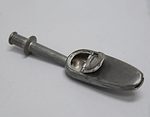Advertise Follow Us
American Farriers Journal

View Archived Issues
November 2020
Volume: 46
Edition: 7
American Farriers Journal is the “hands-on” magazine for professional farriers, equine veterinarians and horse care product and service buyers.
-
Table Of Contents
Table Of Contents
Book ReviewHorse Brain, Human Brain: The Neuroscience of Horsemanship
By Janet L. Jones, PhDRead More6 Keg Shoe Modifications that Save You Money
Invest in basic forging skills to improve your bottom lineRead More2020 Farrier Business Practices SurveyFull-time Farrier Income Skyrockets
Data from the latest Farrier Business Practices Survey shows an 11% increase in yearly gross income compared with 2 years earlierRead MorePros and Cons of Selling Equine Products to Clients
These considerations will guide you to make an informed decision before selling products to your hoof-care clientsRead MoreTips for Hiring Better Hoof-Care Help
Associates must meet tough criteria to be hired by Hall of Fame farrier’s practiceRead MoreThe Success Mindset Can Improve a Farrier’s Career
Colorado farrier explains how the future of your practice hinges on your approachRead MoreMake Shoeing for a Vet Clinic Worth Your While
Prepare for the ups and downs to make your venture successfulRead MoreImprove Your Farrier Business by Setting Boundaries
Maximize your profits with better scheduling and hoof-care clientsRead MoreWill Insurers Require Farrier Liability Coverage?
Increasingly, insurance companies want farriers to carry a liability policy to work in their customers’ barnsRead MoreTips for Pain-Free Arms
Hall of Fame farriers share how they keep their wrists and elbows healthyRead MoreAFJ’s 45th AnniversaryThe Farrier Industry’s Biggest Challenge: Mastering the Basics
Years of study, practice and experience are necessary before a shoer is skilledRead More -
Featured Articles
Featured Articles
6 Keg Shoe Modifications that Save You Money
Invest in basic forging skills to improve your bottom lineRead MoreTips for Pain-Free Arms
Hall of Fame farriers share how they keep their wrists and elbows healthyRead MoreTips for Hiring Better Hoof-Care Help
Associates must meet tough criteria to be hired by Hall of Fame farrier’s practiceRead More - Digital Edition
-
Online Extras
Online Extras




















